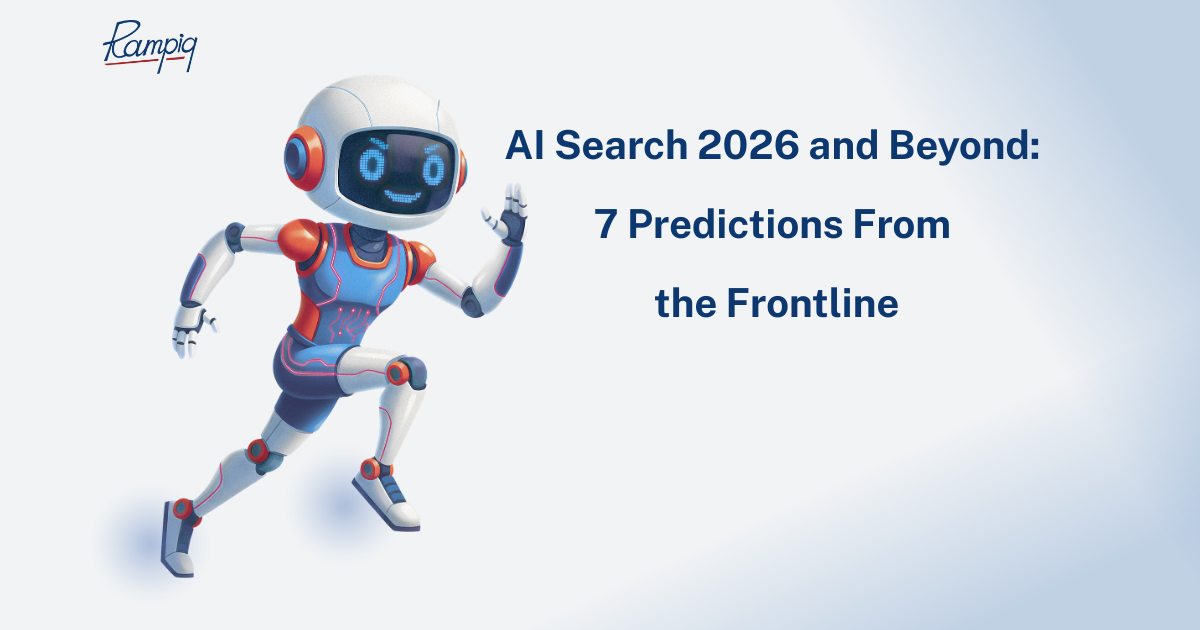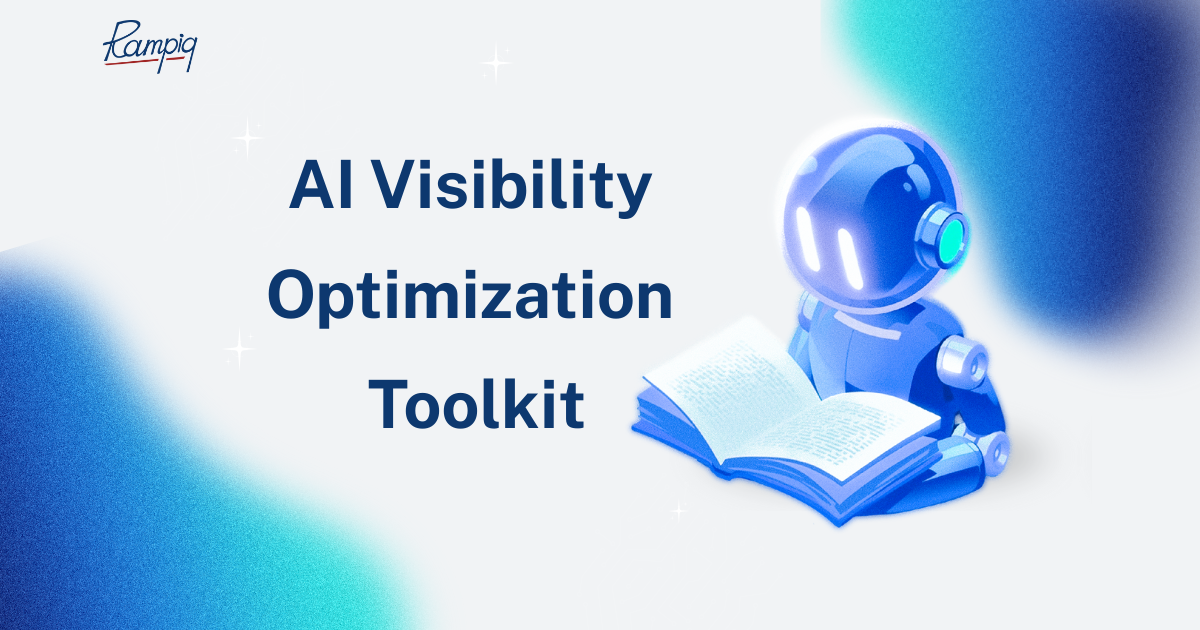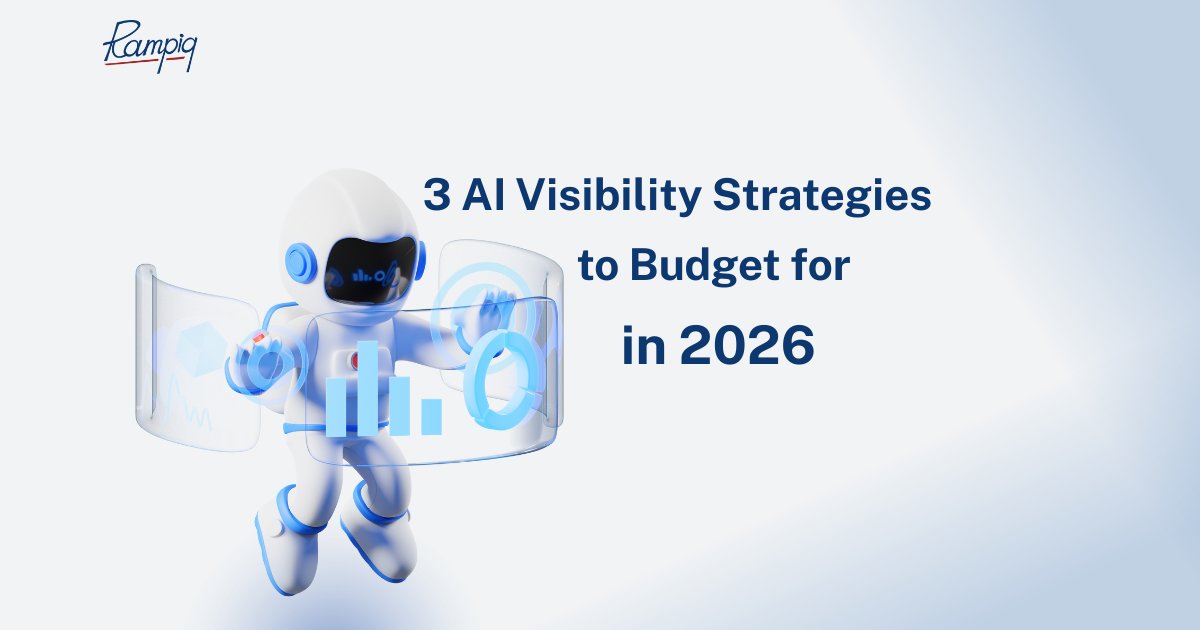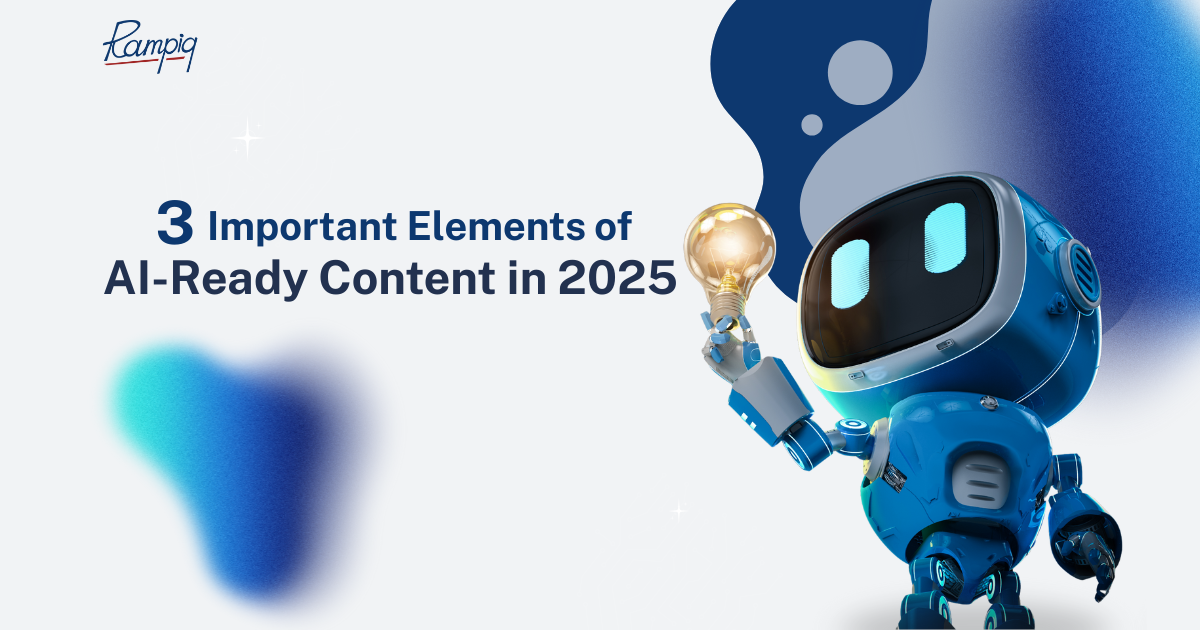How to create a content marketing Strategy
An effective B2B SaaS content marketing strategy is the foundation for success. To get it done properly, you will have to invest the time and resources to create a comprehensive plan that aligns with your SaaS business goals, identifies your target audience, and maximizes your reach and impact.
1. Define Your Target Audience and Their Needs
Understanding who your ideal customers are and what problems they face is central to a successful strategy. Identifying specific needs, preferences, and pain points lets you tailor your content to resonate with your audience, providing value and creating a strong connection with your SaaS solution.
Start by creating a portrait of your ideal customer. For B2B marketing, you need to work out what type of company they would be working at, and then create the portrait of the relevant decision maker.
It is critical to ask the correct questions about the company and the decision-makers within that firm. So, as you define this portrait, consider the following:
For the Company:
- What specific services/products does their company offer? How can we tailor content to the unique demands of those services or products?
- What are the main location-based factors that could affect the target audience’s interest in our product/service? What is trending in that country at this time that we can create content about? How does the culture of this region view such content? What’s their next major holiday, and can we create content on this?
- What is the minimum revenue threshold for the target audience? How can we align the content to their budget?
- How big is the decision-making team, and what roles do they hold? What roles do these topics target?
- What are the top three organizational challenges facing the target audience? How can we address these in the content?
- What are the top three pain points of the target audience? How can we build credibility and trust by addressing these?
- What is our unique value proposition hypothesis? How can we align content to the target audience’s needs and interests?
- What are the strategic goals the target audience aims to achieve? How can we highlight the potential impact of our product/service on those goals?
For the Decision-Makers:
- Who is the primary decision-maker, and what are their pain points? How can we craft content to address their concerns?
- At what stage of the sales process does the decision-maker typically join? How can we create content that resonates with them at that stage?
- What are the common concerns or objections raised during the sales process? How can we address these concerns in the content?
- What factors influence the target audience’s purchasing decision the most? How can we craft content that addresses those factors?
- How active is the decision-maker on social media, and on which platforms? How can we personalize content to make it more effective based on their social media behavior?
2. Conduct Keyword Research to Understand Your Target Audience’s Search Habits
To devise an effective content strategy for SaaS, you must first compile a comprehensive list of informational keywords.
Begin by brainstorming search terms that decision-makers may use when referring to their pain points and challenges. These keywords can be categorized into three groups based on the stage of the marketing funnel they correspond to:
Bottom of the Funnel Keywords
Keywords that target users at the bottom of the sales funnel. They tend to describe the product itself, such as “Tool X vs. Tool Y” (Asana vs Trello), “Top/best tools for X” (best tools for a web design agency), and so on.
Middle of the Funnel Keywords
At this stage, your potential customers recognize they have a problem but haven’t yet figured out how to solve it, or the tools that can help. These keywords focus on providing solutions to the issues that your tool or software addresses.
Top of the Funnel Keywords
Here, you cast a wider net with keywords that may not be directly related to your product but relate to your industry or sector. They are perfect for attracting users from your targeted niche.
Ways to Collect Keywords
Extract the keywords that your competitors use, not only from direct competitors but also from blogs that cater to your niche. This can be done for entire websites or specific blog posts.
To scrape an entire website, use SEMrush to check the entire domain. Utilize filters to sift through keywords relevant to a specific topic or niche.
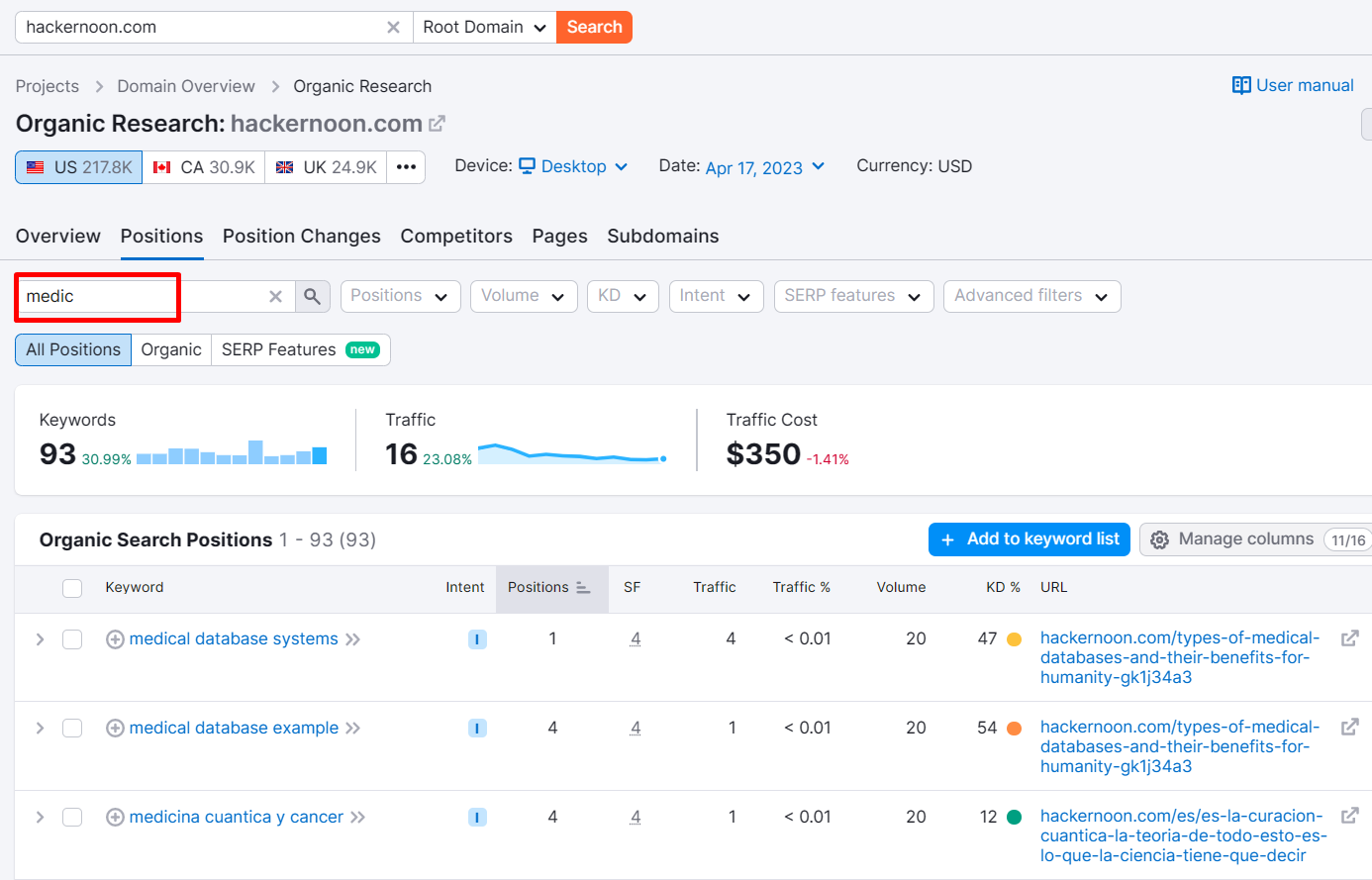
When scraping URLs for a specific article, you can generate a list of keyword suggestions that you may not have considered. From this list, select the relevant keywords that you require and export them.
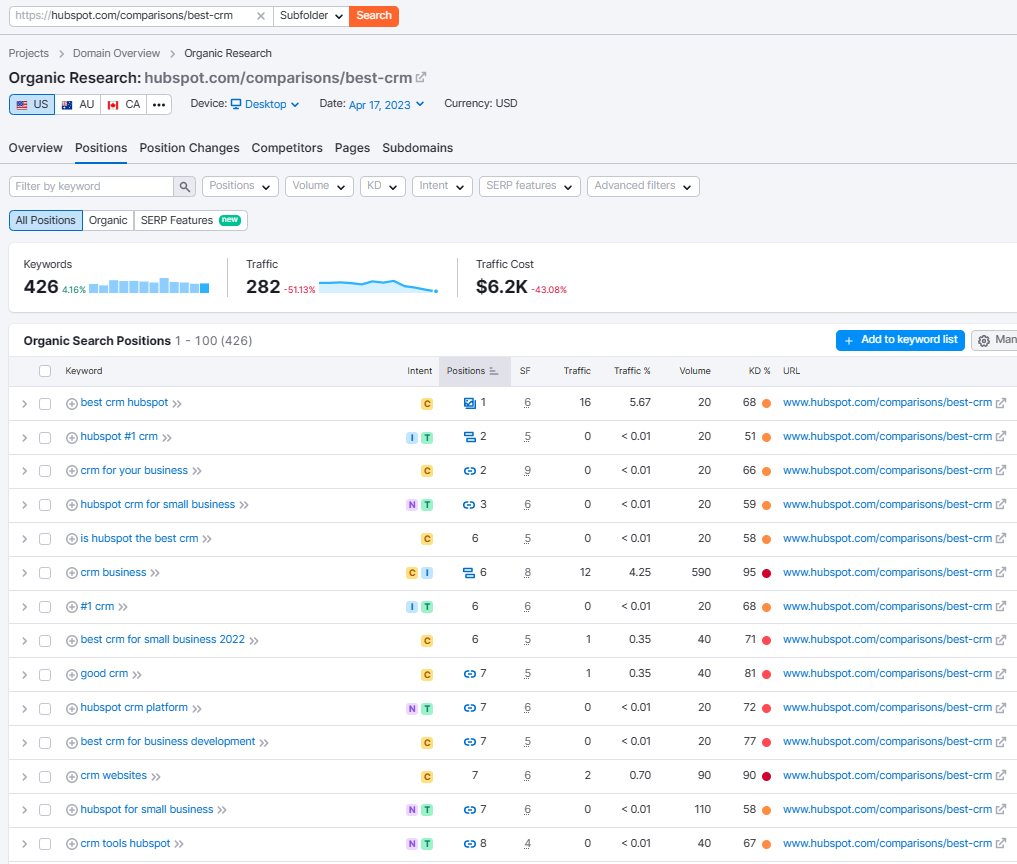
SEMrush’s Keyword Magic Tool is another useful resource for researching keywords related to your niche or topic. You can refine your search by using longer tail keywords or by utilizing the keyword groups offered by SEMrush.
Keyword Research Tips
Tip 1: It’s advisable to start by focusing on BOFU (bottom of the funnel) and MOFU (middle of the funnel) keywords. Ensure that you cover all relevant searches from these stages before proceeding further.
Tip 2: Incorporate long-tail keywords with lower search volume into your strategy. These keywords are less competitive and help you better target your audience.
Long tail keywords also contain short tail keywords, which can help you rank for more competitive short tail keywords in the future, provided you optimize properly. For instance, “best CRM for small businesses in the insurance industry” is an example of a long-tail keyword.
3. Determine Your Brand’s Unique Value Proposition and Messaging
Your unique value proposition differentiates you from your competitors. Determining your brand’s UVP is, therefore, a task of identifying the key benefits and features of your product or service that set it apart from the rest.
Take some time to survey the competition. What are they offering? Where are they lacking? Try to pick out some inadequacies that you can cover.
What problems are not being adequately addressed by existing products or services? Are there any emerging trends or changes in the industry you could capitalize on? Are there any customer segments that are underserved or overlooked by existing products or services?
Once you identify the holes that you can plug, craft a messaging strategy that communicates the value you have established in a way that connects with your customers — in a way that is aligned with their needs.
You must also ensure that you convey the benefits of your product or service in a way that will stick in your clients’ minds and be impactful and not merely list its features. Market research and feedback from your customers will help you understand needs and preferences, and help you tailor both the message and the messaging strategy.
4. Set Achievable, Measurable Goals for Your Content Marketing Efforts
The goals you set for your B2B saas content strategy will typically include the number of articles you plan to publish per month. You can also target certain platforms and channels (such as blogs or LinkedIn posts and emails), and outline some goals for the number of users you want to attract and the number of conversions you hope to achieve.
For each piece of content you include in your content strategy for SaaS, ensure that it’s there to serve a specific purpose, for instance:
- Lead generation: This type of content can be gated, requiring users to provide their contact information in exchange for access. This is usually through high-value materials, such as whitepapers, e-books, or webinars.
You can also use ungated content like blog posts, infographics, and videos – freely accessible content, to attract a broader audience.
Use a combination of gated and ungated content at different stages of the marketing funnel to lead your prospects toward conversion.
- Backlinks: This content is designed to generate links. They mostly include original research, complete guides, unique case studies, or other types of content that other publishers may want to link back to.
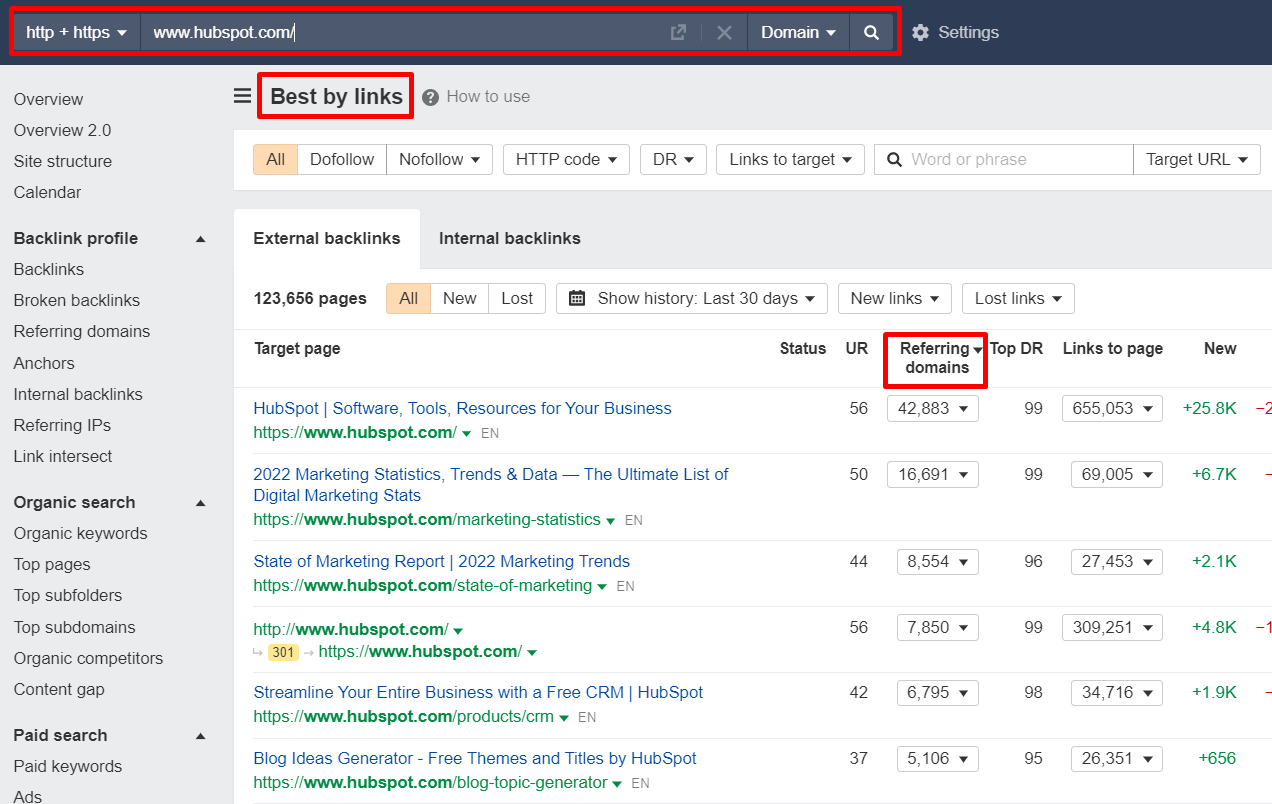
- Organic presence: This content is created to establish topical authority and achieve organic growth
- Social shares: These are posts that are more likely to go onto social media. You can identify them using tools, such as Ahrefs or Buzzsumo.
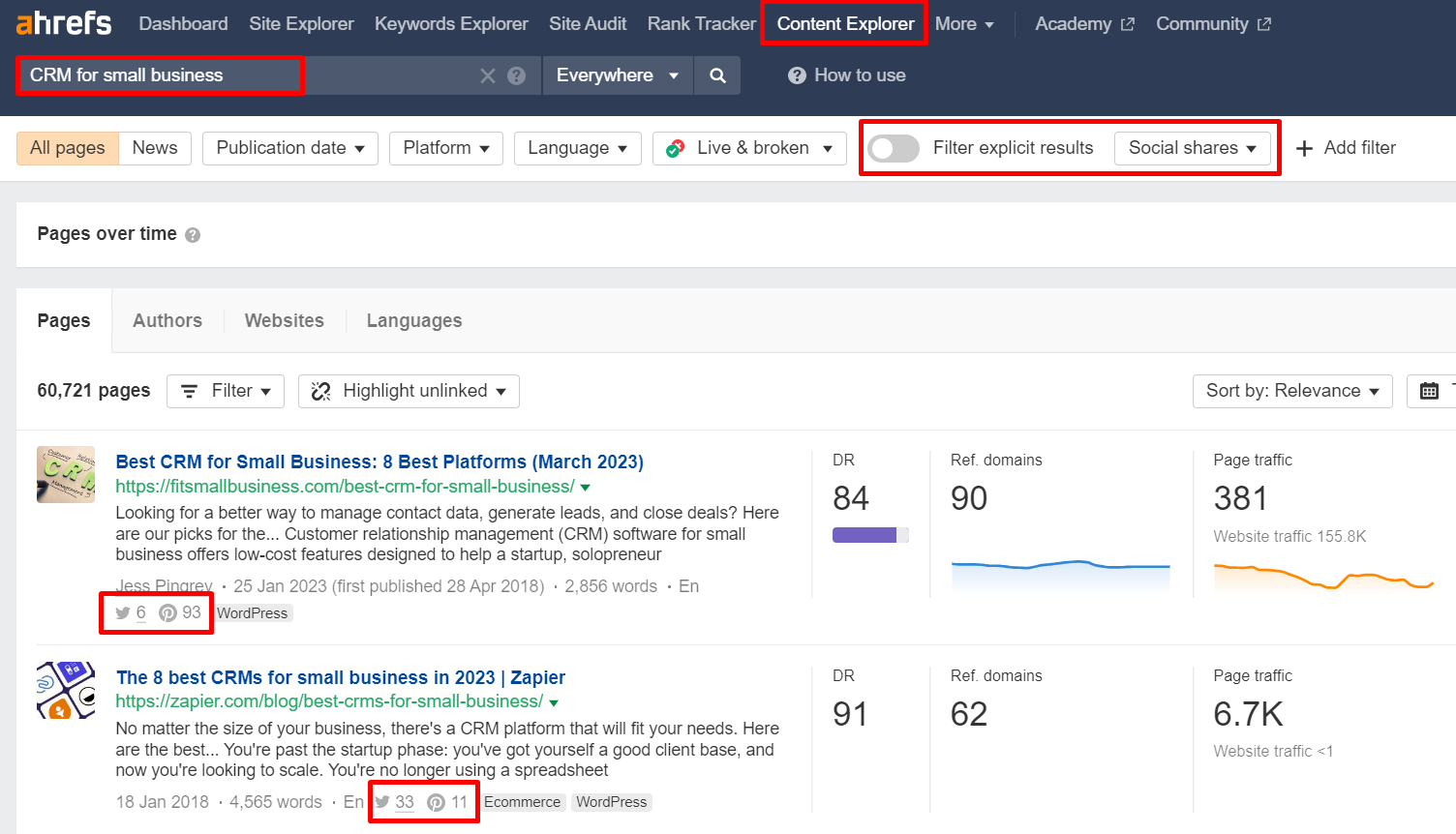
Not every piece will meet all of these goals, but all the same, add them to your B2B SaaS content marketing strategy. For example, you might aim for lead generation posts to make up 20% of your content, social shares to account for another 20%, backlinks to make up 10%, and the remaining 50% to focus on improving search presence.
5. Choose the Right Content Distribution Channels
This step is key to ultimately determining whether the content you are creating reaches the right audience or not. Dedicate enough time and thought into this process to make sure you get it right.
Start by thinking about your target audience and their preferred channels of communication. Where are they more likely to consume content? Is it on social media, via email, or through a blog? You can find this out by carrying out market research and by analyzing your existing audience data.
Secondly, review the types of content you are already creating. Is it all being deployed where it is most effective?
There are some types of content, like long-form articles or white papers, that work better for certain channels – in this case, email, or on your blog. Other types of content, such as visual content or shorter articles, may be more effective on social media.
Third, think about the goals of your content marketing strategy for B2B SaaS. Are you aiming to generate leads, drive website traffic, or improve brand awareness? The answers to these questions will vary. At the end of the day, your choice will be determined by what your goals are.
What you want to do is select distribution channels that tie into and are compatible with your audience’s preferences, your content type, and your goals. This makes for a more cohesive structure in your strategy and facilitates the delivery of your content to the right audience in the right way, and producing the outcomes you expect.
What Types of B2B SaaS Content to Create First?
While the conventional content marketing best practices for SaaS emphasize starting with top-of-the-funnel (TOFU) content to cast a wide net, a more interesting idea, in our opinion, is to start with bottom-of-the-funnel (BOFU) content to immediately capture high-intent prospects:
1. Bottom of Funnel (BOFU) Content
BOFU content targets prospects who are already aware of their problem and are actively seeking a solution. These are essentially the lowest-hanging fruit – prospects who are primed for conversion.
With BOFU content, you address their immediate needs and quickly validate your content marketing efforts by delivering ROI from the outset.
2. Middle of Funnel (MOFU) Content
Once your BOFU content is in place and you’re capturing high-intent leads, you can shift your focus to MOFU content. The purpose of this content is to build on the initial interest and further educate prospects about your solution’s value.
MOFU content should essentially bridge the gap between initial interest and purchase readiness – you offer certain insights into your product, thus you maintain engagement and guide prospects towards a decision-making phase.
3. Top of Funnel (TOFU) Content
Lastly, TOFU content is meant to attract a broad audience and only introduce them to your company and industry.
While essential for long-term growth and awareness, TOFU content typically has lower immediate conversion rates – it helps in casting a wider net and building initial brand awareness.
Types of B2B SaaS Content to Create Based on Funnel Stage
Now that we know our preferred order for content creation, let’s specifically look into what content types to focus on during each individual stage.
For the purposes of our article, we have selected a more traditional marketing funnel, as opposed to an upgraded, modernized version of it; but our advice will still be relevant for both.
Basic Features of Each Funnel Stage:
|
BOFU |
MOFU |
TOFU |
| Main Goal |
Convert |
Nurture |
Educate |
| Conversion Rate |
High |
Average |
Low |
| Buying Intent |
High |
Average |
Low |
| Search Volume |
Low |
Average |
High |
1. BOFU – Decision Stage: Convert
At the decision stage, prospects are ready to make a purchase decision. This content needs to address their final objections, highlight your product’s key benefits, and make it easy to commit to a purchase.
Comparison Pages
Create detailed comparison pages that position your SaaS against your main competitors – highlight your specific advantages, as well as pricing in a way that is favorable and that helps you control the narrative around your product.
Product Pages
You should complete your product pages with very detailed descriptions, benefits, and user testimonials. These pages should serve as the ultimate info resource for those evaluating your SaaS.
Use Case Pages
Don’t forget about use case pages that clearly show how your SaaS can be applied to specific business scenarios or problems.
Case Study Pages
While traditionally considered mid-funnel, case studies can also be highly effective at the BOFU stage if they provide enough in-depth examples – focus on measurable results.
2. MOFU – Consideration Stage: Nurture
The goal here is to nurture the prospects that are already evaluating potential solutions to their problem – to give them content that helps in their research and may prove why your product is the best option.
Interactive Tools
Develop tools like calculators, templates, and questionnaires that could provide prospects with a hands-on experience of your product’s benefits.
Market Intelligence Pieces
Publish various intelligence reports that offer valuable insights into market trends – this helps prospects build a business case for your product by providing authoritative data and analysis.
Product Tour Pages
Create engaging product tour pages that offer a virtual walkthrough of your SaaS’s features.
Ebooks and Whitepapers
Develop in-depth eBooks or whitepapers that explore specific problems in greater detail than any page or article could.
3. TOFU – Awareness Stage: Educate
Prospects at this stage are often just beginning to recognize their pain points and are searching for information to better understand their situation. So focus on positioning your brand as a helpful resource for that – the content should be informative and not overtly sales-driven.
Expanded List Posts and Expert Roundups
Create comprehensive listicles that offer your expert insights into various industry trends or best practices. These tend to be very effective for driving organic traffic and building brand visibility.
“Ultimate” Guides
Make sure to develop guides that will serve as very authoritative resources, addressing key questions or challenges faced by your target audience.
“How-to” Narrative Content
Write practical how-to articles that solve common problems or provide actionable advice related to your product’s domain.
Thought Leadership Pieces
Publish thought-provoking articles and opinion pieces that will showcase your expertise and perspective on various topical subjects.
Infographics
Design visually appealing infographics that simplify complex information or statistics – these are highly shareable and can help with brand visibility by presenting key data in an easily digestible format.
How to Generate Content Ideas for B2B SaaS
In our opinion, the key to compelling content ideas is in asking the right questions – questions that are all about understanding your audience and matching your content with whatever they are looking for.
That’s why it makes sense to start your content marketing for B2B SaaS with the most important question of all:
What Are Your Customers’ Biggest Pain Points?
You can only begin to create meaningful content once you understand what issues it’s supposed to resolve. that offers real solutions. The more data you have about your customer pain points, the better – it’s a big plus if you have insights from customer interactions, support queries, or direct feedback.
As a result, you should have pieces of content each aimed at a specific problem, for example, a detailed blog post explaining how your software addresses inefficiency in project management.
What Results Do Your Customers Care About the Most?
Just as potential customers are interested in the features of your product, they also care about the outcomes. So make sure to create content that specifically highlights those outcomes – a detailed use case or success story that shows how a similar company reduced overhead by X% will be a great idea.
Some additional questions to ask here may look like this:
- How does our SaaS directly impact revenue?
- What metrics matter most to our users?
- What unexpected benefits have users reported after using our product?
How Are Your Competitors Failing to Address Customer Needs?
To truly stand out, your content must also fill gaps that your competitors are leaving open – dig into their blogs, customer reviews, and FAQs to find interesting opportunities. This way, you will be able to position your SaaS as the better, more reliable solution through content like product comparisons, alternative pages, or pricing breakdowns.
What’s Missing in Your Customers’ Journey with Your Product?
An often understated point – don’t forget that once customers begin using your SaaS, their journey with you is far from over. Think about what challenges they can face post-purchase and what barriers exist that prevent them from using your product to the full – content that addresses these will be crucial for your user retention.
You may want to ask yourself:
- What are the most common support queries? (This can spark ideas for an in-depth troubleshooting guide.)
- What onboarding steps cause confusion? (Consider creating an interactive demo to simplify these processes.)
Best Practices for Content Marketing Success
Standing out and attracting potential customers requires that you adhere to content marketing for B2B SaaS best practices. Follow these best practices to maximize your content marketing efforts, increase traffic and produce leads, and build long-term relationships with your audience:
- Emphasize quality over quantity in your content creation
- Build and nurture relationships with influencers and high-authority websites
- Utilize content recycling and repurposing techniques to maximize the value of your content
- Keep up with changes in search engine algorithms and adjust your strategy accordingly
Let’s take a look at these in more detail.
Emphasize Quality over Quantity in Your Content Creation
High-quality content requires time. It demands research, attention to detail, and curiosity that enables you to find and address the challenges of your target audience.
Furthermore, engaging, well-crafted, relevant pieces of content help you build your audience’s trust in your content and cast your brand in a positive light as a thought leader. It also makes for a more pleasant user experience and keeps visitors coming back to your site for valuable insight. It also increases the chances of your content being shared, and the likelihood of being linked back to other websites.
To make your B2B SaaS content marketing efforts more impactful, make publishing in-depth, well-researched articles and resources a priority. This is significantly more impactful than publishing large volumes of content if your goal is to rank higher in search results and attract more organic traffic.
Build and Nurture Relationships with Influencers and High-Authority Websites
Influencer and blogger marketing can lend a powerful boost to SaaS businesses’ brand awareness and sales. You can tap into influencers’ and bloggers’ typically large, devoted, and enthusiastic fan bases to reach a wider audience and achieve more conversions.
Connecting with influencers and bloggers is not always easy. One thing you can do to help things along is to optimize your own brand and grow your influence. It is easier to command attention when you have the influence of your own.
Reach out through social media or email, and engage with their content, but don’t expect that establishing connections will be instantaneous. It will often require patience and persistence.
You will also want to offer value to your potential partners. This could be exclusive access to your product or service, or other incentives for promoting your brand.
Where possible, creative offline favors, like event invitations or meetups, can also help to strengthen relationships if you’re located nearby.
Transparency is key when building trust with influencers. Be clear about your intentions and partnership goals. You want to set them at ease and ensure they feel comfortable advocating for your brand to their audience.
Keep these other tips in mind to enhance your chances of achieving successful influencer collaborations:
- Treat influencers as individuals, understanding their preferences and tailoring your approach accordingly.
- Focus on building relationships and trust, avoiding requests for favors or value before rapport is established.
- Stand out from the crowd with unique, creative strategies that capture influencers’ attention.
- Minimize their investment in collaborations by being judicious with the requests you make for time or financial commitments.
Utilize Content Recycling and Repurposing Techniques to Maximize the Value of Your Content
You also wanted to make the most of your existing content to ensure that your marketing continues to reap the maximum value from it.
Do this by repurposing content that is older than six months, for example, to keep it fresh. You also have to revisit any content that has not received any clicks or receives fewer than ten clicks a month on average. The threshold of ten can be set at your discretion, depending on the specifics of your project.
When assessing your content, consider the following points to help you determine where and how to refresh it:
- Are you creating content mainly for users or for search engines? Content created solely for search engines may not work as well with human visitors. This could undermine your website’s performance.
- Whether or not you are producing a large amount of content and compromising on quality, or using automation to do this, hoping that some of the content will perform well in search results.
- Whether or not you’re tailoring your message to your audience, or simply conforming to current trends and producing content of little relevance to your target audience.
- Whether your content sufficiently answers the questions it is meant to, or, after reading your content, users need to search for additional information on other websites.
- How original the information you are providing is. Is your content unique, or is replicated elsewhere?
- Review how appropriate the heading and title are. Make sure they describe what the page is about, and that the heading isn’t exaggerated.
- Assess the quality of the content. A good test is to see if the content is good enough that you would want to bookmark it.
- As much as possible, lend credence to the content you are putting out by demonstrating or providing evidence that it was written by an expert.
As you update your content, however, you want to make sure that the changes you make bring about actual improvement, not the reverse. So approach your content recycling process deliberately and systematically.
So begin by studying the search engine results pages. Assess what type of content is present, for example, listicles, how-to posts, individual items, and so on. Try to identify what top-ranking pages have in common.
What type of content – reviews, testimonials, articles, and others – do they feature? What are the structures of the websites? What visuals do they use? How long are the top-performing articles?
Also take a look at snippets, what they look like, and what information they include. Do they feature any click magnets? What additional SERP features are in use?
From there, you can then look at your own content and try to implement some best practices:
- Add links to authority sources, research studies, and relevant statistics.
- Use your most targeted keywords near the beginning of the heading and meta title.
- Use targeted keywords within the first 100 words of the content.
- Incorporate keywords into the subheadings and alt texts.
- Add the date when the content was last updated for blog posts.
- Add more content but ensure it delivers additional value.
- Consider merging similar posts into one comprehensive guide.
Fix Your SaaS Content Strategy
We’ll review your content map and show what to keep, fix, and create next so it actually drives pipeline, not just traffic.
Keep up with Changes in Search Engine Algorithms and Adjust Your Strategy Accordingly
Digital marketers are forever chasing the holy grail of online marketing – the search engine algorithms that decide whether or not your website is any good. The algorithms are constantly evolving, so make sure you stay updated with current developments.
Some updates to the algorithms can be disruptive, so you want to make sure you quickly adjust your strategy to account for any new changes. For example, Google’s recent Helpful Content Update may require you to make some adjustments in order to ensure you maintain or improve the SEO performance of your content.
With the constant evolution of these algorithms and the different nuances they always introduce into your content marketing strategy, you want to ensure that you always stay up-to-date with any new developments and adapt in good time.





